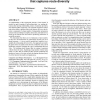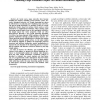945 search results - page 165 / 189 » On Equivalence Between Network Topologies |
SDM
2009
SIAM
14 years 4 months ago
2009
SIAM
Complex systems exhibit emergent patterns of behavior at different levels of organization. Powerful network analysis methods, developed in physics and social sciences, have been s...
SIGCOMM
2006
ACM
14 years 1 months ago
2006
ACM
An understanding of the topological structure of the Internet is needed for quite a number of networking tasks, e.g., making decisions about peering relationships, choice of upstr...
GECCO
2009
Springer
14 years 4 days ago
2009
Springer
Encouraging exploration, typically by preserving the diversity within the population, is one of the most common method to improve the behavior of evolutionary algorithms with dece...
ICDM
2010
IEEE
13 years 5 months ago
2010
IEEE
In recent years, many networks have become available for analysis, including social networks, sensor networks, biological networks, etc. Graph clustering has shown its effectivenes...
IPSN
2007
Springer
14 years 1 months ago
2007
Springer
The development of high-level programming environments is essential if wireless sensor networks are to be accessible to nonexperts. In this paper, we present the Regiment system, ...


